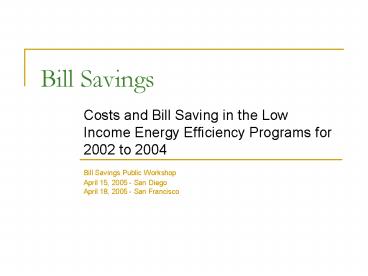Bill Savings - PowerPoint PPT Presentation
1 / 22
Title:
Bill Savings
Description:
r = fuel type (gas or electric) Y = Year, starting with implementation program year ... Supplemental Slide 3 Effect of Average Energy Rate on per Home Bill ... – PowerPoint PPT presentation
Number of Views:17
Avg rating:3.0/5.0
Title: Bill Savings
1
Bill Savings
- Costs and Bill Saving in the Low Income Energy
Efficiency Programs for 2002 to 2004 - Bill Savings Public Workshop
- April 15, 2005 - San DiegoApril 18, 2005 - San
Francisco
2
Introduction
- In 2000, D.00-07-020, Ordering Paragraph 7
ordered the utilities to - ...jointly develop standardized methods for
producing bill savings and expenditures for the
Low Income Energy Efficiency (LIEE) program on an
overall program and per unit basis, by utility. - The methods were developed and the report ordered
in D.00-07-020 was filed on time with errata
filed on March 12, 2001.
3
Introduction (cont.)
- This workshop presents the results of applying
the accepted methodology for determining costs
and bill savings estimates of the LIEE programs
from 2002 through 2004. - A report will be filed that is in compliance with
Decision (D) 01-12-020, Ordering Paragraph 4
4
Costs
- Each LIEE implementer is required to separate
costs into 16 labor, non-labor, and contract
expenditure components.
5
Bill Savings
- Bill savings are the life cycle net present value
saved by the average dwelling due to the measures
installed under the LIEE programs. - Energy savings are determined from engineering
analysis or ME studies performed after the
program was fielded. - Per-unit energy savings for PY2004 are from the
PY2001 LIEE Impact Report and the Final LIEE
Measure Cost Effectiveness Report. - Per-unit energy savings for PY2002-03 are from
the PY2000 LIEE Impact Report and the Draft LIEE
Measure Cost Effectiveness Report. - Many Effective Useful Life values for life cycle
calculation based on CALMAC values, September,
2000. Use of DEER values was assessed but they
were considered inappropriate.
6
Bill Savings (cont.)
- The general algorithm for estimating bill savings
is
where r fuel type (gas or
electric) Y Year, starting with implementation
program year m measure type energy
rateY,r energy rate ( per kWh or therm) for
fuel r in year Y Impactm measure m gross
impact per year (kWh or therm) Numberm
number of measure type m installed EULm
effective useful life (years) of measure type
m CP Costing period, n number of costing
periods
7
Energy Rates
8
Results
- In order to compare average customer bill savings
across the state, it is useful to compare the
total service by service area. For the final
analysis purposes of this document, the SoCalGas
and SCE programs were assessed as a single entity
since they serve roughly the same customers.
9
Results (cont.)
Summary of Bill Savings to Cost Ratios by Service
Area
Summary of Average Per Home Life Cycle Bill
Savings by Service Area
10
Results (cont.) Bill Savings to Cost Ratio- Very
little spread without adjustment.
11
Results (cont.) Per Home Bill Savings Less
spread than previous years without adjustments.
12
Results (cont.)- Effect of Energy Rate on Bill
Savings to cost ratio
PGE SCE/SoCalGas SDGE
Bill Savings to Cost Ratio 0.48 0.47 0.57
Actual PY2004 Energy Rate 0.0975 kWh0.8138 Therm 0.1016 kWh0.8160 Therm 0.119 kWh0.8399 Therm
Assumed Modified Energy Rate 0.1037 kWh0.8232 Therm 0.1037 kWh0.8232 Therm 0.1037 kWh0.8232 Therm
Modified Bill Savings to Cost Ratio 0.51 0.47 0.54
13
Results (cont.)- Investigation of the Effect of
Refrigerator Installation Rate
14
Reasons for Results
- PY2002 variations are due to installation rates
of refrigerators, the impacts for those
refrigerators, and variation in energy rates. - PY2003 reasons for variations are similar to
those for PY2002 refrigerator installation
rate, refrigerator impact values and energy
rates. - PY2004 Very little spread in unadjusted values.
Energy rate had a marginal effect on bill savings
to cost ratio. No other effects.
15
Conclusions
- Unadjusted numbers evolving from the analysis
were within 10 of each other, which is the same
as the levels of agreement achieved in prior bill
savings assessment after adjustments . - Neither the per-unit cost of energy nor the
measure installation rates played major roles in
the utility-to-utility variation. - The main effect for PY2004 was the change in
per-unit impacts seen by SoCalGas resulting from
the updated impact study data.
16
Conclusions
- In short, this analysis shows that the PY2004
LIEE program delivered comparable savings to
program participants statewide.
17
Supplemental Slides
18
Supplemental Slide 1DEER EUL Values Investigated
Measure Bill Savings EUL (yrs) New DEER EUL (yrs) New DEER EUL Source
CFL 8 Varied from 4.45 to 8.2 depending on number of hours of operation Measure Savings Algorithms and Cost Assumptions Technical Reference Manual", Efficiency Vermont, Jan. 2003
Faucet Aerator 5 9 1995 Integrated Resource Plan by Washington Electric Cooperative
Low Flow Showerhead 10 9 1995 Integrated Resource Plan by Washington Electric Cooperative
Refrigerator Replacement 15 18 DEER 4.0
Water Heater Pipe Wrap 15 10 1995 Integrated Resource Plan by Washington Electric Cooperative
Water Heater Replacement 13 15 DEER 4.0
Water Heater Blanket 5 6 1995 Integrated Resource Plan by Washington Electric Cooperative
19
Supplemental Slide 2 - EUL Values Used
20
Supplemental Slide 3 Effect of Average Energy
Rate on per Home Bill Savings
21
Supplemental Slide 4 Results by Utility
22
Supplemental Slide 5 Results Across Utility































